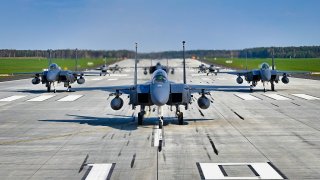A “Diluted” NATO Is a Mistake
NATO once dealt solely with the defense of Europe—until it didn’t. Instead, the alliance is regurgitating ambitions from a quarter of a century ago. This is not progress, just performance.
NATO has marked its seventy-fifth anniversary with a historical airing of Washington’s dirty laundry. U.S. domestic politics trumped this year’s summit—it was less about alliance planning and more about giving Biden a platform to prove he recovered from the cold (or jet lag) that delivered his disastrous debate performance in June.
The 2024 Washington Summit neatly laid bare NATO’s problem: it has forgotten its purpose and lost sight of its central mission. NATO’s 1978 Washington Summit was held in a similarly fraught geopolitical era in which the Soviet threat loomed larger than ever. The 1978 communiqué reiterated the two aims of the alliance—to maintain security and pursue détente. Détente as a concept was not as emotionally charged as it is today. Rationality reigned. Even so, this was not a nod to “appeasement” or weakness—even in 1978, the alliance reiterated the significance of maintaining “vigilance” and keeping “defences at the level rendered necessary.”
Even non-traditional threats like hybrid war or grey-zone challenges were purposefully navigated in 1978. The 1978 NATO summit put on notice “repeated instances in which the Soviet Union and some of its allies have exploited situations of instability and regional conflict.” The alliance refused to shy away from its principal business of modernizing and strengthening Europe’s military capacity.
The 1999 Washington Summit celebrated the alliance’s fiftieth birthday. NATO inked an agenda for the twenty-first century amid a world of conflict and entrenched strategic competition. The Kosovo War was raging, and NATO allies embargoed oil bound to the Federal Republic of Yugoslavia. Compared to today, Europe remains a consumer of Russian hydrocarbons—albeit often via artful sanction dodging. Take Italy, for example. Italy receives much of its gas from Austria, and Austria has increased its imports of Russian gas from 80 percent to 95 percent over the past two years.
Of course, the 1999 summit saw the adaption of NATO’s Membership Action Plan—the rules that today impede Ukraine’s membership. While the United States went into the 2024 Washington Summit with a clear signal to Kyiv that membership was not on the table—the haphazard platitudes of building a “bridge” to membership are disingenuous at best. The 1999 Washington Summit did well to articulate NATO’s basic three-pronged mandate: providing security as “one of” the foundations for a stable Euro-Atlantic, existing as a consultative forum for issues that affect “vital interests,” and delivering deterrence and defense against aggression to member states.
NATO’s 2024 Washington Summit was performative and miles away from the summits of decades ago. External threats are listed, like a shopping list, from China to Russia to Iran. Missing is the alliance’s plan to compete and secure itself. Nor is there an articulation of what the “rules-based international order” actually is and how it is a “vital” interest.
If NATO had not already signaled its unseriousness, the deeper fostering of Asia at the 2024 Summit surely did. If NATO’s strategic aim today is to “modernise NATO for a new era of collective defence,” then by the basic definition of the Washington Treaty, this does not include states like Australia or New Zealand. Both are well south of the Tropic of Cancer—the limits of NATO’s geographical zoning for collective defense.
Yet, leaders (or, in Canberra’s case—a representative) of Australia, Japan, New Zealand, and the Republic of Korea featured prominently in summit activities or photo opportunities. NATO of the 90s (and 70s) knew its purpose and showed necessary strategic restraint in its geographical boundaries. NATO must get back to its origin and rediscover its principal purpose: to enhance the security and stability of the Euro-Atlantic area.
Globalization might have made the world “smaller” and more interconnected, but time has not changed geography. Asia is not Europe. While both regions share security challenges and opportunities, these are simply not vital ones. It does not neatly follow that an attempt to redraw the map in Europe necessitates Australian intervention. An overly emotive response to this position clouds reality.
Arguably, Beijing will move on Taiwan according to its own cost-benefit assessment. The idea that inserting Washington (or Canberra) further into Kyiv’s fight would somehow change Beijing’s calculus is extraordinarily simplistic and dangerous. But that is where we are today when it comes to the notion of deterrence. It has become an exercise in folly and self-aggrandizement.
NATO is not just veering out of the area—betraying its own geographical boundaries—it is seeking to do all of these things. The alliance has developed a capacity problem. While its capability problems are better known, its attempt to diversify across a litany of traditional and non-traditional security threats has merely seen Brussels spread itself too thin. All the threats and all the domains seem now to have found a place in NATO’s pantry of problems. This was not always the case; just look at climate change.
The 2024 Washington Summit underscored NATO’s commitment to becoming “the leading international organization for understanding and adapting to the impacts of climate change and extreme weather on security.” Yet five years ago, NATO Secretary General Jens Stoltenberg told me: “NATO is not the tool to solve the climate change challenge.” He doubled down, stating NATO “will not be the tool or the international platform where we make climate change agreements.” Setting aside the debate as to the security threat posed by climate change for a moment, just five years ago, NATO apparently knew its mission parameters.
Today, NATO’s purpose is to defend against “all threats and challenges, in all domains, and in multiple strategic directions.” This would be funny if it weren’t so shocking. If NATO is to be everything to everyone, then it is simply set to be nothing to all. Asia, under the construct of the political notion of an “Indo-Pacific,” has evidently been shoehorned into NATO’s confused identity.
Of course, this is not the first time that Asia has knocked at NATO’s door. In a May 1952 conversation with U.S. Secretary of State Dean Acheson, Australian Ambassador to Washington (Sir Spender) laid out Canberra’s NATO thirst. Spender noted, “Australia was not content to be the hair on the tail of the dog.” Australia sought to be “part of the hide of the dog itself.” Acheson quite rightly hosed the Aussie down—noting, “the Australian position was based to a considerable extent on a fundamental misconception…that NATO is involved in global planning.”
Overall, the NATO narrative of alliance stability and cohesion jars with several members’ bilateral ties with Moscow, Beijing, or—for some member states—both. The 2024 Summit noted China “cannot enable the largest war in Europe in recent history without this negatively impacting its interests and reputation.” Singling out China in the 2024 Washington Summit but failing also to demand more of member states who have ushered Beijing into every nook and cranny of their economies is duplicitous.
Yet, China continues to enable the war—selling drones to both Ukraine and Russia—all while maintaining economic relationships with much of NATO. Just look at European port infrastructure. The dual-use implications are evident for maritime trade and naval asset positioning. Greece, Turkey, and Spain are home to ports over which China has a majority stake. Italy, France, the Netherlands, and Germany have ports in which China is a minority shareholder. Impressively for NATO’s headquarters, Belgium’s Zeebrugge port features a terminal with a significant Chinese stake.
Reflecting on NATO’s Washington Summits through history, it is apparent that very little is new in terms of the challenges the alliance faces. Response, however, has become NATO’s central deficiency. The alliance has been pushed and pulled in too many directions and has lost sight of its core responsibilities.
A quarter of a century ago, NATO was grappling with how to ensure “efficient production and availability of advanced weapons and technology in support of security for all its members.” This begs the question: why is NATO still treading water on these goals?
There are some calls to “kneecap” NATO, like Dr. Sumantra Maitra’s proposal for a “dormant NATO.” I fear it is too late for this to be done in any meaningful (let alone successful) manner. Politics will surely muddy any attempt at reform. But it is critical to shift the burden of European defense back to something akin to balance. This will no doubt require a slimming down of NATO’s ambition to be everything for everyone.
Hard choices, prioritization, and a return to first principles from incoming Secretary General Mark Rutte must occur. Only then will the alliance secure longevity in any meaningful way.
NATO once dealt solely with the defense of Europe—until it didn’t. Instead, the alliance is regurgitating ambitions from a quarter of a century ago. This is not progress, just performance. The 2025 NATO Summit will be held in The Netherlands. Hopefully, Mr. Rutte has a plan.
About the Author:
Dr. Elizabeth Buchanan is a Senior Fellow at the Australian Strategic Policy Institute and an Expert Associate of the Australian National University’s National Security College. She is a former official of the Australian Department of Defence. Follow her on X: @BuchananLiz.
Image: Shutterstock.com.


